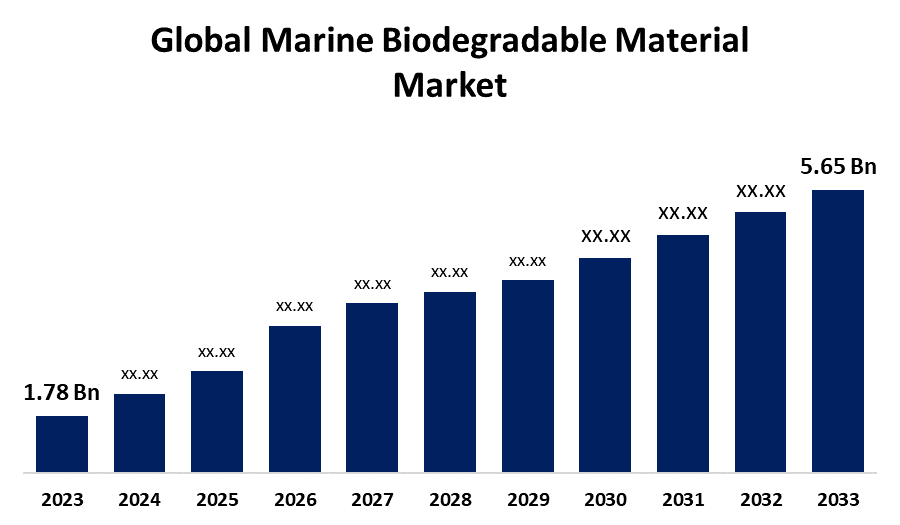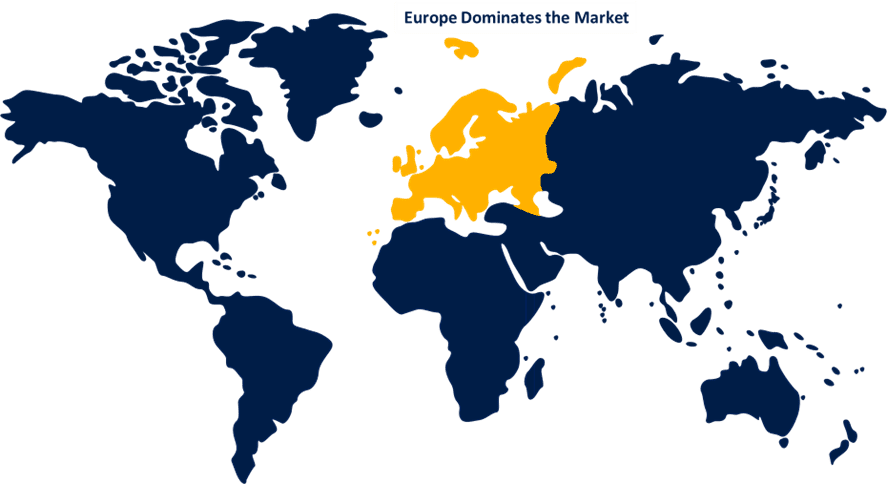Global Marine Biodegradable Material Market Size, Share, and COVID-19 Impact Analysis, By Material Type (Starch Blends, Polyhydroxyalkanoates (PHA), Polylactic Acid (PLA), Cellulose Blends, and Others), By Application (Consumer Goods, Agriculture, Textiles, Packaging, and Others), By Region (North America, Europe, Asia-Pacific, Latin America, Middle East, and Africa), Analysis and Forecast 2023 - 2033.
Industry: Chemicals & MaterialsGlobal Marine Biodegradable Material Market Insights Forecasts to 2033
- The Global Marine Biodegradable Material Market Size was estimated at USD 1.78 Billion in 2023
- The Market Size is Expected to Grow at a CAGR of around 12.24% from 2023 to 2033
- The Worldwide Marine Biodegradable Material Market Size is Expected to Reach USD 5.65 Billion by 2033
- Asia-Pacific is expected to grow the fastest during the forecast period.

Get more details on this report -
The Global Marine Biodegradable Material Market Size is expected to cross USD 5.65 Billion by 2033, growing at a CAGR of 12.24% from 2023 to 2033. The global marine biodegradable material market is expanding rapidly due to growing environmental concerns and stringent regulations against plastic pollution in marine ecosystems. Biodegradable polymer innovations, such as PHA and PLA, are driving market growth, with applications ranging from packaging to fishing gear and disposable products. Asia-Pacific and Europe are leading the market, aided by government policies and rising consumer demand for environmentally friendly alternatives.
Market Overview
The global marine biodegradable material market includes eco-friendly materials that naturally degrade in marine environments, thereby reducing plastic pollution and environmental impact. These materials, which include biopolymers such as PHA, PLA, and starch blends, are used to promote ocean sustainability through packaging, fishing gear, and disposable products. The marine biodegradable material market has significant growth potential, driven by rising environmental awareness and stringent regulations on plastic waste. One of the primary opportunities is the development of new and improved biodegradable materials with enhanced properties such as increased durability and faster degradation rates in marine environments. Companies are investing heavily in R&D to discover novel materials that can replace traditional plastics. For instance, In January 2025, Panasonic Holdings Corporation (Panasonic HD) developed a molding material that is completely marine biodegradable by incorporating highly concentrated plant-derived cellulose fiber into resins. Panasonic HD was able to create a molding material with both excellent mechanical properties and marine biodegradability by adding high concentrations of plant-derived cellulose fiber to marine biodegradable resin.
Report Coverage
This research report categorizes the marine biodegradable material market based on various segments and regions forecasts revenue growth and analyzes trends in each submarket. The report analyses the key growth drivers, opportunities, and challenges influencing the marine biodegradable material market. Recent market developments and competitive strategies such as expansion, type launch, development, partnership, merger, and acquisition have been included to draw the competitive landscape in the market. The report strategically identifies and profiles the key market players and analyses their core competencies in each sub-segment of the marine biodegradable material market.
Global Marine Biodegradable Material Market Report Coverage
| Report Coverage | Details |
|---|---|
| Base Year: | 2023 |
| Market Size in 2023 : | USD 1.78 Billion |
| Forecast Period: | 2023 – 2033 |
| Forecast Period CAGR 2023 – 2033 : | 12.24% |
| 023 – 2033 Value Projection: | USD 5.65 Billion |
| Historical Data for: | 2019-2022 |
| No. of Pages: | 210 |
| Tables, Charts & Figures: | 111 |
| Segments covered: | By Material Type, By Application, By Regional Analysis |
| Companies covered:: | FKuR Kunststoff GmbH, NatureWorks LLC, Tianan Biologic Material Co., Ltd., Danimer Scientific, Plantic Technologies Limited, Biome Bioplastics Limited, BASF SE, Total Corbion PLA, Novamont S.p.A., Mitsubishi Chemical Corporation, Cardia Bioplastics, Zhejiang Hisun Biomaterials Co., Ltd., Green Dot Bioplastics, Futerro SA, Others, and |
| Pitfalls & Challenges: | COVID-19 Impact Analysis and Forecast 2023 - 2033 |
Get more details on this report -
Driving Factors
Consumer awareness and preferences also play an important role in driving the market. Consumers are increasingly turning to eco-friendly products as they become more aware of the importance of environmental sustainability. This shift in consumer behavior encourages manufacturers in a variety of industries, including packaging, agriculture, and consumer goods, to use marine biodegradable materials in their products, thereby driving market growth. Furthermore, in recent years, there has been a surge of interest in biodegradable glitter as an environmentally friendly alternative to traditional plastic-based glitter. This innovative product is made from plant-based materials like cellulose, allowing it to degrade naturally in the environment without leaving harmful residues. Biodegradable glitter is becoming increasingly popular in industries such as cosmetics, arts and crafts, and events, where there is a demand for sustainable and environmentally conscious products. As consumers become more aware of the environmental impact of microplastics, the shift to biodegradable alternatives such as biodegradable glitter is expected to help drive the overall growth of the marine biodegradable material market.
Restraining Factors
One of the most significant challenges is the high cost of producing biodegradable materials compared to traditional plastics. The production of biodegradable materials frequently involves complex and expensive technologies, which can impede their widespread adoption. Furthermore, the performance properties of biodegradable materials, such as durability and strength, may not always be comparable to those of conventional plastics, making their use in certain applications challenging.
Market Segmentation
The marine biodegradable material market share is classified into material type and application.
- The polylactic acid (PLA) segment held the greatest share in 2023 and is anticipated to grow at a significant CAGR during the forecast period.
Based on the material type, the marine biodegradable material market is divided into starch blends, polyhydroxyalkanoates (PHA), polylactic acid (PLA), cellulose blends, and others. Among these, the polylactic acid (PLA) segment held the greatest share in 2023 and is anticipated to grow at a significant CAGR during the forecast period. The growth can be attributed to its widespread availability, low cost, and strong mechanical properties, which make it a viable alternative to traditional plastics. PLA is made from renewable sources like corn starch and sugarcane, making it an eco-friendly material for packaging, single-use products, and fishing gear. Furthermore, growing regulatory support for biodegradable materials, particularly in Europe and North America, has accelerated PLA adoption across a variety of industries.
- The packaging segment accounted for the majority of the share in 2023 and is estimated to grow at the fastest CAGR during the projected timeframe.
Based on the application, the marine biodegradable material market is divided into consumer goods, agriculture, textiles, packaging, and others. Among these, the packaging segment accounted for the majority of the share in 2023 and is estimated to grow at the fastest CAGR during the projected timeframe. This is due to the growing demand for eco-friendly alternatives to traditional plastic packaging. Governments around the world are enforcing strict regulations to reduce plastic pollution, particularly in marine environments, which has accelerated the use of biodegradable materials in food packaging, e-commerce, and retail industries. Furthermore, increasing consumer awareness and preference for environmentally friendly packaging solutions has prompted companies to invest in marine biodegradable materials such as PLA, PHA, and starch-based biopolymers.
Regional Segment Analysis of the Marine Biodegradable Material Market
- North America (U.S., Canada, Mexico)
- Europe (Germany, France, U.K., Italy, Spain, Rest of Europe)
- Asia-Pacific (China, Japan, India, Rest of APAC)
- South America (Brazil and the Rest of South America)
- The Middle East and Africa (UAE, South Africa, Rest of MEA)
Europe is anticipated to hold the largest share of the marine biodegradable material market over the predicted timeframe.

Get more details on this report -
Europe is anticipated to hold the largest share of the marine biodegradable material market over the predicted timeframe. This is due to strict environmental regulations, strong government support for sustainability, and widespread consumer awareness of plastic pollution. The European Union has implemented stringent policies, such as the Single-Use Plastics Directive, which prohibits certain non-biodegradable plastic products and encourages the use of environmentally friendly alternatives. Furthermore, Europe has a well-developed waste management infrastructure and a high adoption rate for biodegradable materials in industries such as packaging, agriculture, and fishing. Leading market players and research institutions in the region are constantly investing in the development of novel marine biodegradable materials, accelerating market growth. The presence of major biopolymer manufacturers, as well as increasing corporate commitments to sustainability, help Europe maintain its dominant market position.
Asia-Pacific is expected to grow at the fastest CAGR growth of the marine biodegradable material market during the forecast period. Rapid industrialization, rising population, and growing environmental awareness in countries such as China, India, and Japan are driving up demand for biodegradable materials. These countries' governments are putting in place regulations to reduce plastic waste and encourage the use of sustainable materials.
Competitive Analysis:
The report offers the appropriate analysis of the key organizations/companies involved within the marine biodegradable material market along with a comparative evaluation primarily based on their type of offering, business overviews, geographic presence, enterprise strategies, segment market share, and SWOT analysis. The report also provides an elaborative analysis focusing on the current news and developments of the companies, which includes type development, innovations, joint ventures, partnerships, mergers & acquisitions, strategic alliances, and others. This allows for the evaluation of the overall competition within the market.
List of Key Companies
- FKuR Kunststoff GmbH
- NatureWorks LLC
- Tianan Biologic Material Co., Ltd.
- Danimer Scientific
- Plantic Technologies Limited
- Biome Bioplastics Limited
- BASF SE
- Total Corbion PLA
- Novamont S.p.A.
- Mitsubishi Chemical Corporation
- Cardia Bioplastics
- Zhejiang Hisun Biomaterials Co., Ltd.
- Green Dot Bioplastics
- Futerro SA
- Others
Key Target Audience
- Market Players
- Investors
- End-users
- Government Authorities
- Consulting And Research Firm
- Venture capitalists
- Value-Added Resellers (VARs)
Recent Developments
- In December 2023, The Mitsubishi Chemical Group (MCG Group) was pleased to announce that its plant-derived compostable polymer BioPBS was certified as a marine biodegradable biomass plastic in November 2023 under the Japan BioPlastics Association's marine biodegradable plastic identification and labeling system.
Market Segment
- This study forecasts revenue at global, regional, and country levels from 2023 to 2033. Spherical Insights has segmented the marine biodegradable material market based on the below-mentioned segments:
Global Marine Biodegradable Material Market, By Material Type
- Starch Blends
- Polyhydroxyalkanoates (PHA)
- Polylactic Acid (PLA)
- Cellulose Blends
- Others
Global Marine Biodegradable Material Market, By Application
- Consumer Goods
- Agriculture
- Textiles
- Packaging
- Others
Global Marine Biodegradable Material Market, By Regional Analysis
- North America
- US
- Canada
- Mexico
- Europe
- Germany
- UK
- France
- Italy
- Spain
- Russia
- Rest of Europe
- Asia Pacific
- China
- Japan
- India
- South Korea
- Australia
- Rest of Asia Pacific
- South America
- Brazil
- Argentina
- Rest of South America
- Middle East & Africa
- UAE
- Saudi Arabia
- Qatar
- South Africa
- Rest of the Middle East & Africa
Frequently Asked Questions (FAQ)
-
1. What is the CAGR of the marine biodegradable material market over the forecast period?The marine biodegradable material market is projected to expand at a CAGR of 12.24% during the forecast period.
-
2. What is the market size of the marine biodegradable material market?The Global Marine Biodegradable Material Market Size is Expected to Grow from USD 1.78 Billion in 2023 to USD 5.65 Billion by 2033, at a CAGR of 12.24% during the forecast period 2023-2033.
-
3. Which region holds the largest share of the marine biodegradable material market?Europe is anticipated to hold the largest share of the marine biodegradable material market over the predicted timeframe.
Need help to buy this report?